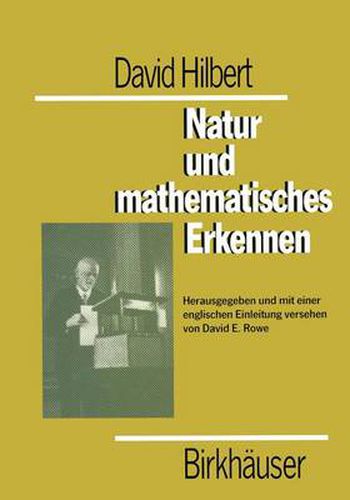Readings Newsletter
Become a Readings Member to make your shopping experience even easier.
Sign in or sign up for free!
You’re not far away from qualifying for FREE standard shipping within Australia
You’ve qualified for FREE standard shipping within Australia
The cart is loading…






This title is printed to order. This book may have been self-published. If so, we cannot guarantee the quality of the content. In the main most books will have gone through the editing process however some may not. We therefore suggest that you be aware of this before ordering this book. If in doubt check either the author or publisher’s details as we are unable to accept any returns unless they are faulty. Please contact us if you have any questions.
At the time of David Hilbert’s death in 1943, his leading disciple, Her- mann Weyl, wrote that
… the era of mathematics upon which he impressed the seal of his spirit and which is now sinking below the horizon achieved a more perfect balance than prevailed before and after, between the mastering of concrete problems and the formation of general abstract concepts. l Weyl attributed this happy equilibrium in no small part to Hilbert ‘s work and its influence, adding that no mathematician of equal stature has risen from our generation., 2 Surely, it would be difficult to exaggerate the importance of Hilbert’s contributions to twentieth-century mathematics or even to conceive of what mathematics today would be like without them. He overturned the concep- tual framework of older fields ranging from invariant theory and algebraic number theory to the foundations of geometry. He rehabilitated the Dirich- let Principle, propelled integral equation theory to the forefront of active research, derived the field equations governing Einstein’s general theory of relativity, created modern proof theory and metamathematics, and through- out his career he championed the power and efficacy of the axiomatic method not only for mathematics but for all of the exact sciences. Every educated mathematician knows something about Hilbert space, the Hilbert problems, and Hilbert ’s formalist program.
$9.00 standard shipping within Australia
FREE standard shipping within Australia for orders over $100.00
Express & International shipping calculated at checkout
This title is printed to order. This book may have been self-published. If so, we cannot guarantee the quality of the content. In the main most books will have gone through the editing process however some may not. We therefore suggest that you be aware of this before ordering this book. If in doubt check either the author or publisher’s details as we are unable to accept any returns unless they are faulty. Please contact us if you have any questions.
At the time of David Hilbert’s death in 1943, his leading disciple, Her- mann Weyl, wrote that
… the era of mathematics upon which he impressed the seal of his spirit and which is now sinking below the horizon achieved a more perfect balance than prevailed before and after, between the mastering of concrete problems and the formation of general abstract concepts. l Weyl attributed this happy equilibrium in no small part to Hilbert ‘s work and its influence, adding that no mathematician of equal stature has risen from our generation., 2 Surely, it would be difficult to exaggerate the importance of Hilbert’s contributions to twentieth-century mathematics or even to conceive of what mathematics today would be like without them. He overturned the concep- tual framework of older fields ranging from invariant theory and algebraic number theory to the foundations of geometry. He rehabilitated the Dirich- let Principle, propelled integral equation theory to the forefront of active research, derived the field equations governing Einstein’s general theory of relativity, created modern proof theory and metamathematics, and through- out his career he championed the power and efficacy of the axiomatic method not only for mathematics but for all of the exact sciences. Every educated mathematician knows something about Hilbert space, the Hilbert problems, and Hilbert ’s formalist program.